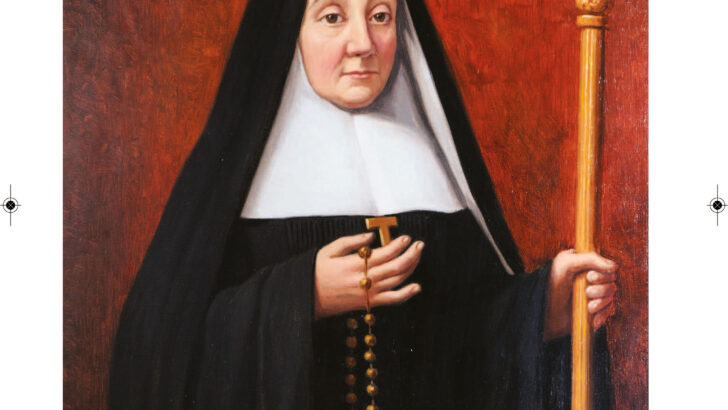Brides of Christ: Women and Monasticism in Medieval and Early Modern Ireland, edited by Martin Browne OSB, Tracy Collins, Bronagh McShane and Colmán Ó Clabaigh OSB (Four Courts Press, €50.00/ £45.00)
Patricia Rumsey
As the number of candidates for religious life apparently dwindles, so the wider interest in religious life – and particularly women’s monastic life – seems to increase. Although female monastic life has changed out of all recognition in its external manifestations from the way it was lived in the Middle Ages, in its fundamental core structures – the Eucharist, the Divine Office and the rest of the liturgical cycle, the vows, manual labour and community life – though expressed and lived out in different ways – it remains largely unchanged.
The various contributors to this volume are all experts in their respective specialist fields of monastic study and this is a work to be savoured by academics, but also to be greatly enjoyed by the interested and well-informed general reader.
Scholarship
Just to glance at the list of contributors reveals the breadth of scholarship contained within this extremely elegant and handsome volume and Four Courts Press are to be congratulated for a book which is a pleasure to hold and a treasure to explore, whatever one’s degree of expertise in the subject matter here contained.
In this work the authors present medieval Irish nuns under various headings which situate them in their respective contexts. Tracy Collins explores the archaeological evidence and describes at least 51 monasteries in early medieval Ireland ranging from the great and famous houses such as that of Brigid in Kildare to the lesser female religious communities such as that of St Buonia, the supposed sister of St Patrick, at Killabuonia in Co. Kerry. Elva Johnson presents the so far untapped witness of early Irish martyrologies where female saints are commemorated on their respective feast days.
Catherine Swift gives us a scholarly introduction to Brigit and Ita, probably the two best known Irish holy women, and puts them in their late antique context.
Dagmar Ó Riain-Raedel, to whom this work is dedicated “in recognition of her outstanding contribution to Irish and European medieval history”, and in particular “medieval Irish-Germanic relations”, shows how ‘peregrinatio’ – that essentially Irish ascetic practice – was lived out by nuns as far away as Germany.
Yvonne Seale compares the Irish nuns of Ballymore-Loughsewdy with the Premonstratensians in France, while Mary Ann Lyons remains nearer home with the familial connections of abbesses and prioresses in Ireland in the Middle Ages.
Monastic life
Colmán Ó Clabaigh widens the horizon and looks at the lives of “marginal figures – quasi religious women” such as widows, anchoresses, solitaries, tertiaries and others who, because of circumstances or choice did not adopt the full monastic life as lived conventionally in religious houses.
In contrast to Ó Clabaigh’s wider vision, Colm Lennon hones in on the confraternity of sisters of Christ Church Cathedral in Dublin in the late Middle Ages.
Bronagh Ann McShane in the penultimate chapter looks at some of the individual nuns who lived and worked in the 17th Century and assesses the importance of their text translations and vestment embroidery work during a difficult period of persecution and dispersion, concentrating particularly on the Poor Clare sisters of Galway and also the Dominicans and Benedictines.
Bishop Anne Dyer concludes with an epilogue in which she celebrates the importance of these women who lived long ago, emphasising the prayer which lay at the heart of their calling, and which remains at the heart of all those following the Christ in whatever way today: “We may not know what religious women in the past thought, how they understood themselves or their shared vocation, but we do know what they prayed, because those are the same prayers that we say today, day after day” (p.176).
This is why this is such an important work; it brings before us those Christian women the external circumstances of whose lives were so very different from ours today, and yet who are united to us by the even closer bonds of faith, hope and love of the Risen Christ and who can be an example and an inspiration to Christians of the 21st Century, even for those not called to the monastic vocation.
They knew the same contours of the land, they prayed and worshipped in many of the same places, they recognised many of the same saints, they used the same formulae of prayers, even if not always in the same tongue.
They are our sisters in the faith and this book brings them alive for us today.
Dr Patricia Rumsey, Mother Abbess of the Poor Clare community in Arkley, Barnet, is honorary Associate Professor of The University of Nottingham.


 Portrait of Abbess Mary Joseph Butler OSB (1641-1732). Reproduced courtesy of the Benedictine Monastery Archive, Kylemore Abbey, Co. Galway.
Portrait of Abbess Mary Joseph Butler OSB (1641-1732). Reproduced courtesy of the Benedictine Monastery Archive, Kylemore Abbey, Co. Galway. 